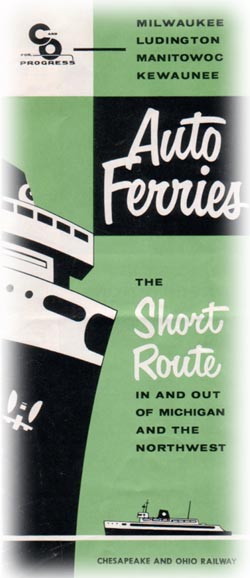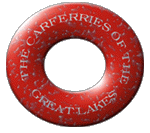


By MARJORIE PAASCH
Once, I was a queen. Today, just a cut-down river barge, stripped of handsome passenger staterooms, grand dining room, comfortable lounges and the pleasant, courteous personnel which made lake crossings so enjoyable.
It stands out vividly - that first docking at my home port more than forty years ago! Flags and pennants flying, salutes from the other ships in the harbor. Even the switch crew waiting to unload my cargo gave the familiar two longs, one short, and two longs on the whistle of the steam locomotive.
Then the tours of inspection of the newest ship of the line. People went all over me, from the coal bunkers, the furnaces, the car deck and up the stairs to view the staterooms, dining room, lounge and even the galley and storage rooms. The pilot house and radio room were open and the ship's officers explained the navigational instruments and how they worked.
However, queen or not, I was a working ship, and soon made my regularly scheduled two round trips a day to the Wisconsin side of the lake, winter and summer, fair weather and foul. Summer days, passengers would stay on deck the entire trip, but there were many cold winter days when my decks were covered with ice. Several times I hit the breakwater tip and once punched a huge hole in my bow.
Heading for home on November 11, 1940, I was tossed up on the beach like a huge whale, helpless, and my people hurting. I was lucky that Armistice Day. My cargo was damaged, my sea gate buckled, and there were various casualties, but three ships sank close by, and many sailors drowned, but I survived.
For nine years. I was the flagship. Periodically, lounges and staterooms were redecorated and carpeted, new chairs and divans added, but the polished wood paneled walls remained to the end. Then, three new ferries were built -- one a year. Several older boats were sold to be remodeled for the St. Clair River traffic. My sister ship, in dry dock for inspection and overhauling, burned beyond repair. I, also, had my share of troubles, and showed the ravages of time. The steel plates of my sides, once so smooth, were pitted and rough from many scrapings of rust and blistered paint.
Although the lake crossing route was the fastest, it was not the cheapest. A belt line was constructed around Chicago, which eliminated that bottleneck. Shippers favored the less expensive way, and business fell off. With the newer ferries designed for handling higher loads, the "piggy-back" freight cars, and top deck parking for the automobiles crossing the lake, I was taken out of service, put "in the mud", a spot near the slips, and my crew paid off. A watchman made regular patrols to keep off unauthorized persons.
The marine shop crew dismantled and removed pieces of equipment that could be used on the other ships. One day, a tug came and towed me out of the harbor for the last time. No flags or whistles that day, but many cars lined the beach road, and their drivers blew horns in salute to an old lady as I slipped past. Welders in a shipyard dry dock cut my superstructure down so that just the bare minimum remained of the once proud queen of the lake. If you look at my stern, however, you can identify me – City of Flint – Pere Marquette 32.
 Back to
the Main Page
Back to
the Main Page